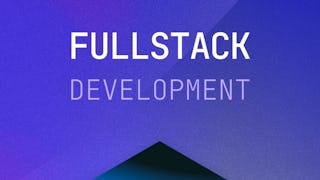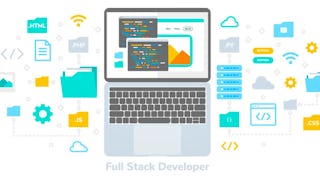- Browse
- Elastic Stack
Elastic Stack Courses
Elastic Stack courses can help you learn data ingestion, real-time analytics, and visualization techniques. You can build skills in managing logs, monitoring system performance, and creating dashboards that provide actionable insights. Many courses introduce tools like Elasticsearch for searching and analyzing data, Logstash for data processing, and Kibana for visualizing data trends, allowing you to apply these skills in practical scenarios.
Popular Elastic Stack Courses and Certifications
 Status: NewNewStatus: Free TrialFree Trial
Status: NewNewStatus: Free TrialFree TrialSkills you'll gain: DevOps, CI/CD, Application Deployment, Cloud Development, Development Environment, Cloud Applications, Continuous Deployment, Version Control, Amazon Elastic Compute Cloud, Continuous Integration, Real Time Data, Kibana, Query Languages, Data Modeling, Distributed Computing, SQL, Data Mapping, NoSQL, Event-Driven Programming, Relational Databases
Beginner · Specialization · 1 - 3 Months
 Status: Free TrialFree Trial
Status: Free TrialFree TrialSkills you'll gain: Data Import/Export, Data Visualization Software, Data Visualization, Restful API, Data Mapping, Interactive Data Visualization, Histogram, Data Transformation, Amazon Web Services, Data Processing, Cloud Platforms, Apache Kafka, Scalability, Information Architecture, System Monitoring, Application Performance Management, Cloud Computing, Data Management, JSON, Data Structures
4.4·Rating, 4.4 out of 5 stars13 reviewsBeginner · Specialization · 1 - 3 Months
 Status: NewNewStatus: Free TrialFree TrialS
Status: NewNewStatus: Free TrialFree TrialSScrimba
Skills you'll gain: Prompt Engineering, Responsive Web Design, Node.JS, Command-Line Interface, TypeScript, Unit Testing, SQL, HTML and CSS, Web Content Accessibility Guidelines, Typography, Cascading Style Sheets (CSS), Ajax, React.js, User Interface and User Experience (UI/UX) Design, Hypertext Markup Language (HTML), JavaScript Frameworks, JSON, Generative AI, Database Design, UI Components
4.6·Rating, 4.6 out of 5 stars794 reviewsBeginner · Specialization · 3 - 6 Months
 Status: Free TrialFree TrialStatus: AI skillsAI skills
Status: Free TrialFree TrialStatus: AI skillsAI skillsSkills you'll gain: Prompt Engineering, Software Development Life Cycle, Cloud-Native Computing, Istio, Software Architecture, Kubernetes, CI/CD, Cloud Computing Architecture, Application Deployment, React Redux, Node.JS, Responsive Web Design, Restful API, Django (Web Framework), Git (Version Control System), Server Side, Hypertext Markup Language (HTML), Cloud Computing, Data Import/Export, Engineering Software
Build toward a degree
4.6·Rating, 4.6 out of 5 stars59K reviewsBeginner · Professional Certificate · 3 - 6 Months
 Status: Free TrialFree Trial
Status: Free TrialFree TrialSkills you'll gain: Software Development Life Cycle, Istio, Software Architecture, Node.JS, Application Deployment, Restful API, Kubernetes, React Redux, Database Design, CI/CD, Cloud-Native Computing, Responsive Web Design, NoSQL, OpenShift, Git (Version Control System), Cloud Applications, Ajax, Javascript, Azure DevOps, Engineering Software
4.6·Rating, 4.6 out of 5 stars8.7K reviewsBeginner · Professional Certificate · 3 - 6 Months
 Status: NewNewStatus: Free TrialFree Trial
Status: NewNewStatus: Free TrialFree TrialSkills you'll gain: Node.JS, Responsive Web Design, JSON, jQuery, Restful API, HTML and CSS, Bootstrap (Front-End Framework), API Design, GitHub, Git (Version Control System), Postman API Platform, Web Design, Hypertext Markup Language (HTML), Web Development, MongoDB, Back-End Web Development, Server Side, Full-Stack Web Development, Cascading Style Sheets (CSS), Web Development Tools
Beginner · Specialization · 3 - 6 Months
What brings you to Coursera today?
 Status: Free TrialFree Trial
Status: Free TrialFree TrialSkills you'll gain: Responsive Web Design, Cascading Style Sheets (CSS), Web Development, Javascript, Bootstrap (Front-End Framework), Scripting, Browser Compatibility, Application Programming Interface (API), Back-End Web Development
4.4·Rating, 4.4 out of 5 stars686 reviewsBeginner · Course · 1 - 4 Weeks
 Status: Free TrialFree TrialM
Status: Free TrialFree TrialMMicrosoft
Skills you'll gain: CI/CD, GitHub, C# (Programming Language), HTML and CSS, Load Balancing, Continuous Integration, Git (Version Control System), Role-Based Access Control (RBAC), Scalability, Object Oriented Programming (OOP), Authentications, ASP.NET, Full-Stack Web Development, Web Development, Debugging, SQL, Application Deployment, Microsoft Copilot, .NET Framework, Graph Theory
4.6·Rating, 4.6 out of 5 stars318 reviewsBeginner · Professional Certificate · 3 - 6 Months
 Status: Free TrialFree Trial
Status: Free TrialFree TrialSkills you'll gain: Jest (JavaScript Testing Framework), Django (Web Framework), Version Control, Restful API, Responsive Web Design, Cascading Style Sheets (CSS), Unix Commands, HTML and CSS, Git (Version Control System), GitHub, Relational Databases, Object Oriented Programming (OOP), Database Management Systems, Bootstrap (Front-End Framework), React.js, Mobile Development, SQL, Database Design, API Design, Python Programming
4.7·Rating, 4.7 out of 5 stars25K reviewsBeginner · Specialization · 3 - 6 Months
 Status: Free TrialFree TrialStatus: AI skillsAI skills
Status: Free TrialFree TrialStatus: AI skillsAI skillsSkills you'll gain: Prompt Engineering, Software Development Life Cycle, Cloud-Native Computing, Software Architecture, Hibernate (Java), Database Design, Responsive Web Design, Docker (Software), Containerization, Git (Version Control System), GitHub, Object Oriented Programming (OOP), Microservices, CI/CD, Restful API, Java Programming, Engineering Software, Version Control, Database Management, Software Design
4.6·Rating, 4.6 out of 5 stars6.9K reviewsBeginner · Professional Certificate · 3 - 6 Months
 Status: Free TrialFree Trial
Status: Free TrialFree TrialSkills you'll gain: Web Applications, API Design, User Interface (UI), User Provisioning, Databases, Scalability, GitHub, Command-Line Interface, Data Validation
4.6·Rating, 4.6 out of 5 stars45 reviewsBeginner · Specialization · 3 - 6 Months
 Status: Free TrialFree Trial
Status: Free TrialFree TrialSkills you'll gain: MongoDB, Node.JS, Angular, Restful API, API Design, NoSQL, Bootstrap (Front-End Framework), Database Development, Scalability, JavaScript Frameworks, Authentications, Query Languages, Web Applications, Authorization (Computing), JSON, Javascript and jQuery, Database Management, Security Controls, Distributed Computing, Web Design and Development
4.7·Rating, 4.7 out of 5 stars161 reviewsBeginner · Specialization · 3 - 6 Months
In summary, here are 10 of our most popular elastic stack courses
- Elastic Stack Mastery with Elasticsearch & AWS: EDUCBA
- Elasticsearch 8 and the Elastic Stack: In-Depth and Hands-On: Packt
- Fullstack Development: Scrimba
- IBM Full Stack Software Developer: IBM
- IBM Full-Stack JavaScript Developer: IBM
- Full Stack Web Development Mastery - Novice to Expert: Packt
- Introduction to HTML, CSS, & JavaScript: IBM
- Microsoft Full-Stack Developer: Microsoft
- Meta Full Stack Developer: Front-End & Back-End from Scratch: Meta
- IBM Java Developer: IBM
Frequently Asked Questions about Elastic Stack
Elastic Stack is a set of open-source tools developed by Elastic that allows users to collect, store, analyze, and visualize large volumes of data in real-time. It is commonly used for search, logging, metrics analysis, and security analytics purposes. Elastic Stack consists of several components, including Elasticsearch, Logstash, Beats, and Kibana, each serving a specific function:
Elasticsearch: A distributed search and analytics engine that stores and indexes data in real-time, enabling powerful searching, aggregating, filtering, and analyzing capabilities.
Logstash: A data processing pipeline that ingests data from multiple sources, performs transformations, and sends it to various outputs, such as Elasticsearch for indexing and storage.
Beats: Lightweight data shippers that can send data from thousands of sources to Elasticsearch or Logstash. Beats include various modules tailored for specific use cases, like Filebeat for ingesting log files or Metricbeat for collecting and shipping system and application metrics.
- Kibana: A data visualization and exploration platform that leverages the indexed data in Elasticsearch to create interactive dashboards, charts, and graphs. It allows users to analyze data, monitor system performance, and gain insights through visualizations.
By utilizing Elastic Stack, users can centralize their data, search and analyze it efficiently, detect anomalies, and gain valuable insights from their data in real-time.
To learn Elastic Stack, you would need to focus on the following skills:
Elasticsearch: Understanding the fundamentals of Elasticsearch is crucial as it is the main component of the Elastic Stack. This includes learning how to index, search, and analyze large volumes of data efficiently.
Logstash: Logstash is another important component that helps in processing and transforming data. You should learn how to configure Logstash pipelines to ingest data from various sources and transform it as required.
Kibana: Kibana is the visualization and reporting tool in the Elastic Stack. Learning how to create visualizations, dashboards, and perform data analysis using Kibana is essential to effectively utilize the stack.
Beats: Beats are lightweight data shippers that send data from various sources to Elasticsearch or Logstash. Understanding how to configure and use different Beats to collect data from diverse sources is crucial.
X-Pack: X-Pack is a set of additional features and functionalities that enhance the Elastic Stack. It includes security, monitoring, alerting, machine learning, and more. Learning how to utilize and configure these components will provide you with advanced capabilities.
Querying and aggregations: Developing proficiency in querying and aggregating data using the Elasticsearch Query DSL is important for extracting insights and performing advanced data analysis.
Data modeling: Understanding how to design and structure your data in Elasticsearch for efficient querying and indexing is crucial. This includes knowledge of data types, mappings, and analyzers.
Distributed systems: As Elastic Stack is built to handle large-scale data, understanding distributed systems concepts such as sharding, replication, and scaling will help optimize performance and reliability.
Troubleshooting and debugging: Learning how to troubleshoot and debug issues in the Elastic Stack, including performance optimizations and identifying errors, is invaluable.
- Continuous learning: As the Elastic Stack evolves, it is important to stay updated with the latest features, best practices, and community resources to leverage its full potential.
Remember that while these skills are essential for working with Elastic Stack, the specific requirements may vary depending on your use case and the problem you intend to solve.
There are several jobs that you can pursue with Elastic Stack skills. Some of them include:
Elastic Stack Developer: As an Elastic Stack Developer, you would be responsible for designing, implementing, and maintaining Elasticsearch, Logstash, and Kibana solutions for various applications. You would also ensure data indexing, search functionality, and visualization meet the requirements of the project.
Elastic Stack Administrator: As an Elastic Stack Administrator, your role would involve managing and maintaining the infrastructure and configuration of the Elastic Stack. You would handle tasks such as cluster management, monitoring, troubleshooting, and security implementation.
Data Engineer: With Elastic Stack skills, you can work as a Data Engineer, focusing on processing and analyzing large amounts of data. You would utilize the Elastic Stack to ingest, transform, and analyze data, ensuring efficient data pipelines and optimal performance.
Security Analyst: As a Security Analyst, your responsibility would be to set up and manage the security features within the Elastic Stack. You would work on tasks related to threat detection, anomaly detection, log analysis, and incident response, in order to protect the organization's systems and data.
Search Engineer: Search Engineers work on developing and optimizing search functionality within applications. With Elastic Stack skills, you can work on designing and implementing advanced search features, improving relevance, and enhancing search performance.
- Data Analyst: Elastic Stack skills can also open up opportunities as a Data Analyst. In this role, you would utilize the capabilities of Elasticsearch, Logstash, and Kibana to analyze and visualize data, derive insights, create dashboards, and support data-driven decision-making.
These are just a few examples of jobs that you can consider with Elastic Stack skills. The demand for professionals with expertise in the Elastic Stack is growing rapidly as organizations seek to harness the power of data for various purposes.
People who are best suited for studying Elastic Stack are those who have a background or interest in data analysis, data engineering, or software development. They should have a strong understanding of databases, data structures, and programming languages such as Java or Python. Additionally, individuals who are comfortable working with large datasets and have a problem-solving mindset would excel in studying Elastic Stack.
There are several topics that you can study related to Elastic Stack, which is a powerful set of open source software used for search, log analytics, and data visualization. Here are some possible topics:
Elasticsearch: Learn about the fundamentals of Elasticsearch, including data indexing, search queries, and distributed searching.
Logstash: Explore how Logstash can be used for log collection, filtering, and transformation before sending data to Elasticsearch.
Kibana: Discover how to use Kibana for data visualization and exploration, creating dashboards, and monitoring.
Beats: Study the various types of Beats, which are lightweight data shippers for capturing and sending data to Elasticsearch and Logstash.
X-Pack: Dive into the added features and functionalities provided by Elastic's X-Pack, including security, monitoring, machine learning, and more.
- Elastic Stack Integration: Explore how Elastic Stack can be integrated with other tools and technologies such as Kafka, Hadoop, and Spark for enhanced data processing and analytics.
These topics will help you gain a comprehensive understanding of Elastic Stack and its components, enabling you to leverage its capabilities for effective search, log analysis, and data visualization in various domains and industries.
Online Elastic Stack courses offer a convenient and flexible way to enhance your knowledge or learn new Elastic Stack is a set of open-source tools developed by Elastic that allows users to collect, store, analyze, and visualize large volumes of data in real-time. It is commonly used for search, logging, metrics analysis, and security analytics purposes. Elastic Stack consists of several components, including Elasticsearch, Logstash, Beats, and Kibana, each serving a specific function:
Elasticsearch: A distributed search and analytics engine that stores and indexes data in real-time, enabling powerful searching, aggregating, filtering, and analyzing capabilities.
Logstash: A data processing pipeline that ingests data from multiple sources, performs transformations, and sends it to various outputs, such as Elasticsearch for indexing and storage.
Beats: Lightweight data shippers that can send data from thousands of sources to Elasticsearch or Logstash. Beats include various modules tailored for specific use cases, like Filebeat for ingesting log files or Metricbeat for collecting and shipping system and application metrics.
- Kibana: A data visualization and exploration platform that leverages the indexed data in Elasticsearch to create interactive dashboards, charts, and graphs. It allows users to analyze data, monitor system performance, and gain insights through visualizations.
By utilizing Elastic Stack, users can centralize their data, search and analyze it efficiently, detect anomalies, and gain valuable insights from their data in real-time. skills. Choose from a wide range of Elastic Stack courses offered by top universities and industry leaders tailored to various skill levels.
When looking to enhance your workforce's skills in Elastic Stack, it's crucial to select a course that aligns with their current abilities and learning objectives. Our Skills Dashboard is an invaluable tool for identifying skill gaps and choosing the most appropriate course for effective upskilling. For a comprehensive understanding of how our courses can benefit your employees, explore the enterprise solutions we offer. Discover more about our tailored programs at Coursera for Business here.










